A Comparative Study of Different Dimensionality Reduction Algorithms for Hyperspectral Prediction of Salt Information in Saline–Alkali Soils of Songnen Plain, China
Abstract
:1. Introduction
2. Material and Method
2.1. Study Area
2.2. Soil Property Measurements
2.3. Soil Surface Cracking Experiments
2.4. Crack Feature Extraction
2.5. Spectra Measurement
2.6. Dimensionality Reduction
2.6.1. Random Forest Algorithm
2.6.2. Principal Component Analysis
2.6.3. Correlation Analysis
2.7. Multivariate Linear Model
2.8. Accuracy Evaluation
3. Result
3.1. Soil Parameters
3.2. Crack Parameters
3.3. Spectral Characteristics
3.4. Screening Results of Spectroscopy
3.4.1. Random Forest Algorithm
3.4.2. Principal Component Analysis
3.4.3. Pearson Correlation Coefficients
3.5. Multiple Linear Regression Models
Prediction Models
4. Discussion
5. Conclusions
Author Contributions
Funding
Institutional Review Board Statement
Data Availability Statement
Acknowledgments
Conflicts of Interest
References
- Global Soil Data Task Group. Global Gridded Surfaces of Selected Soil Characteristics (IGBP-DIS); Oak Ridge National Laboratory Distributed Active Archive Center: Oak Ridge, TN, USA, 2000.
- Mazhar, S.; Pellegrini, E.; Contin, M.; Bravo, C.; De Nobili, M. Impacts of salinization caused by sea level rise on the biological processes of coastal soils-a review. Front. Environ. Sci. 2022, 10, 909415. [Google Scholar] [CrossRef]
- Nachshon, U. Cropland soil salinization and associated hydrology: Trends, processes and examples. Water 2018, 10, 1030. [Google Scholar] [CrossRef]
- Zhao, C.; Zhang, H.; Song, C.; Zhu, J.-K.; Shabala, S. Mechanisms of plant responses and adaptation to soil salinity. Innovation 2020, 1, 100017. [Google Scholar] [CrossRef] [PubMed]
- Elsawy, M.B.; Lakhouit, A. A review on the impact of salinity on foundation soil of coastal infrastructures and its implications to north of Red Sea coastal constructions. Arab. J. Geosci. 2020, 13, 555. [Google Scholar] [CrossRef]
- Yang, J.; Yao, R.; Wang, X.; Xie, W.; Zhang, X.; Zhu, W.; Zhang, L.; Sun, R. Research on salt-affected soils in China: History, status quo and prospect. Acta Pedol. Sin. 2022, 59, 10–27. (In Chinese) [Google Scholar]
- Zhou, Z.; Li, Z.; Zhang, Z.; You, L.; Xu, L.; Huang, H.; Wang, X.; Gao, Y.; Cui, X. Treatment of the saline-alkali soil with acidic corn stalk biochar and its effect on the sorghum yield in western Songnen Plain. Sci. Total Environ. 2021, 797, 149190. [Google Scholar] [CrossRef]
- Vanderlinden, K.; Martínez, G.; Ramos, M.; Laguna, A.; Vanwalleghem, T.; Peña, A.; Carbonell, R.; Ordóñez, R.; Giráldez, J.V. Soil Salinity Patterns in an Olive Grove Irrigated with Reclaimed Table Olive Processing Wastewater. Water 2022, 14, 3049. [Google Scholar] [CrossRef]
- De Carlo, L.; Vivaldi, G.A.; Caputo, M.C. Electromagnetic induction measurements for investigating soil salinization caused by saline reclaimed water. Atmosphere 2021, 13, 73. [Google Scholar] [CrossRef]
- Gu, S.; Jiang, S.; Li, X.; Zheng, N.; Xia, X. Soil salinity simulation based on electromagnetic induction and deep learning. Soil Till. Res. 2023, 230, 105706. [Google Scholar] [CrossRef]
- Paz, A.M.; Castanheira, N.; Farzamian, M.; Paz, M.C.; Gonçalves, M.C.; Santos, F.A.M.; Triantafilis, J. Prediction of soil salinity and sodicity using electromagnetic conductivity imaging. Geoderma 2020, 361, 114086. [Google Scholar] [CrossRef]
- Khadim, F.K.; Su, H.; Xu, L.; Tian, J. Soil salinity mapping in Everglades National Park using remote sensing techniques and vegetation salt tolerance. Phys. Chem. Earth Parts A/B/C 2019, 110, 31–50. [Google Scholar] [CrossRef]
- Peng, J.; Biswas, A.; Jiang, Q.; Zhao, R.; Hu, J.; Hu, B.; Shi, Z. Estimating soil salinity from remote sensing and terrain data in southern Xinjiang Province, China. Geoderma 2019, 337, 1309–1319. [Google Scholar] [CrossRef]
- Wang, J.; Ding, J.; Yu, D.; Ma, X.; Zhang, Z.; Ge, X.; Teng, D.; Li, X.; Liang, J.; Lizaga, I. Capability of Sentinel-2 MSI data for monitoring and mapping of soil salinity in dry and wet seasons in the Ebinur Lake region, Xinjiang, China. Geoderma 2019, 353, 172–187. [Google Scholar] [CrossRef]
- Li, X.; Ren, J.; Zhao, K.; Liang, Z. Correlation between spectral characteristics and physicochemical parameters of soda-saline soils in different states. Remote Sens. 2019, 11, 388. [Google Scholar] [CrossRef]
- Hu, J.; Peng, J.; Zhou, Y.; Xu, D.; Zhao, R.; Jiang, Q.; Fu, T.; Wang, F.; Shi, Z. Quantitative estimation of soil salinity using UAV-borne hyperspectral and satellite multispectral images. Remote Sens. 2019, 11, 736. [Google Scholar] [CrossRef]
- Mandal, A.K. The need for the spectral characterization of dominant salts and recommended methods of soil sampling and analysis for the proper spectral evaluation of salt affected soils using hyper-spectral remote sensing. Remote Sens. Lett. 2022, 13, 588–598. [Google Scholar] [CrossRef]
- Das, A.; Bhattacharya, B.K.; Setia, R.; Jayasree, G.; Das, B.S. A novel method for detecting soil salinity using AVIRIS-NG imaging spectroscopy and ensemble machine learning. ISPRS J. Photogramm. 2023, 200, 191–212. [Google Scholar] [CrossRef]
- Wang, L.; Zhang, B.; Shen, Q.; Yao, Y.; Zhang, S.; Wei, H.; Yao, R.; Zhang, Y. Estimation of soil salt and ion contents based on hyperspectral remote sensing data: A case study of Baidunzi basin, China. Water 2021, 13, 559. [Google Scholar] [CrossRef]
- Pan, B.; Cai, S.; Zhao, M.; Cheng, H.; Yu, H.; Du, S.; Du, J.; Xie, F. Predicting the surface soil texture of cultivated land via hyperspectral remote sensing and machine learning: A case study in Jianghuai hilly area. Appl. Sci. 2023, 13, 9321. [Google Scholar] [CrossRef]
- Cui, J.; Chen, X.; Han, W.; Cui, X.; Ma, W.; Li, G. Estimation of soil salt content at different depths using UAV multi-spectral remote sensing combined with machine learning algorithms. Remote Sens. 2023, 15, 5254. [Google Scholar] [CrossRef]
- Bangelesa, F.; Adam, E.; Knight, J.; Dhau, I.; Ramudzuli, M.; Mokotjomela, T.M. Predicting soil organic carbon content using hyperspectral remote sensing in a degraded mountain landscape in lesotho. Appl. Environ. Soil Sc. 2020, 2020, 2158573. [Google Scholar] [CrossRef]
- Ge, H.; Han, Y.; Xu, Y.; Zhuang, L.; Wang, F.; Gu, Q.; Li, X. Estimating soil salinity using multiple spectral indexes and machine learning algorithm in Songnen plain, China. IEEE J. Sel. Top. Appl. Earth Obs. Remote Sens. 2023, 16, 7041–7050. [Google Scholar] [CrossRef]
- Bian, J.; Tang, J.; Lin, N. Relationship between saline–alkali soil formation and neotectonic movement in Songnen Plain, China. Environ. Geol. 2008, 55, 1421–1429. [Google Scholar] [CrossRef]
- Wang, L.; Seki, K.; Miyazaki, T.; Ishihama, Y. The causes of soil alkalinization in the Songnen Plain of Northeast China. Paddy Water Environ. 2009, 7, 259–270. [Google Scholar] [CrossRef]
- Singh, A. Environmental problems of salinization and poor drainage in irrigated areas: Management through the mathematical models. J. Clean. Prod. 2019, 206, 572–579. [Google Scholar] [CrossRef]
- Wichelns, D.; Qadir, M. Achieving sustainable irrigation requires effective management of salts, soil salinity, and shallow groundwater. Agric. Water Manag. 2015, 157, 31–38. [Google Scholar] [CrossRef]
- Nick, S.M.; Copty, N.K.; Saygın, S.D.; Öztürk, H.S.; Demirel, B.; Emadian, S.M.; Erpul, G.; Sedighi, M.; Babaei, M. Impact of soil compaction and irrigation practices on salt dynamics in the presence of a saline shallow groundwater: An experimental and modelling study. Hydrol. Process. 2024, 38, e15135. [Google Scholar] [CrossRef]
- Ren, J.; Li, X.; Zhao, K.; Fu, B.; Jiang, T. Study of an on-line measurement method for the salt parameters of soda-saline soils based on the texture features of cracks. Geoderma 2016, 263, 60–69. [Google Scholar] [CrossRef]
- Yang, F.; Wang, Z.; Wang, Y.; An, F.; Yang, H. Soil water characteristic of saline-sodic soil in Songnen Plain. Sci. Geogr. Sin. 2015, 35, 340–345. (In Chinese) [Google Scholar]
- Li, B.; Wang, Z.; Liang, Z.; Chi, C. Distribution characteristics of Ions in sodic soil and correlation analysis. Chin. J. Soil Sci. 2007, 38, 653–656. (In Chinese) [Google Scholar]
- Bai, L.; Wang, C.; Zang, S.; Wu, C.; Luo, J.; Wu, Y. Mapping soil alkalinity and salinity in Northern Songnen Plain, China with the HJ-1 hyperspectral imager data and partial least squares regression. Sensors 2018, 18, 3855. [Google Scholar] [CrossRef]
- Li, X.; Li, Y.; Wang, B.; Sun, Y.; Cui, G.; Liang, Z. Analysis of spatial-temporal variation of the saline-sodic soil in the west of Jilin Province from 1989 to 2019 and influencing factors. Catena 2022, 217, 106492. [Google Scholar] [CrossRef]
- Zeng, H.; Tang, C.; Cheng, Q.; Inyang, H.I.; Rong, D.; Lin, L.; Shi, B. Coupling effects of interfacial friction and layer thickness on soil desiccation cracking behavior. Eng. Geol. 2019, 260, 105220. [Google Scholar] [CrossRef]
- Al-Jeznawi, D.; Sanchez, M.; Al-Taie, A.J. Using image analysis technique to study the effect of boundary and environment conditions on soil cracking mechanism. Geotech. Geol. Eng. 2021, 39, 25–36. [Google Scholar] [CrossRef]
- Zhang, H.; Li, C.; Xue, H.; Lin, C.; Zheng, Y. Dark background correction of the infrared detector for hyperspectral remote sensing application. Sens. Actuators A Phys. 2023, 349, 114088. [Google Scholar] [CrossRef]
- Shaikh, M.S.; Jaferzadeh, K.; Thörnberg, B.; Casselgren, J. Calibration of a hyper-spectral imaging system using a low-cost reference. Sensors 2021, 21, 3738. [Google Scholar] [CrossRef] [PubMed]
- Noviyanto, A.; Abdulla, W.H. Segmentation and calibration of hyperspectral imaging for honey analysis. Comput. Electron. Agric. 2019, 159, 129–139. [Google Scholar] [CrossRef]
- Ren, J.; Zhao, K.; Wu, X.; Zheng, X.; Li, X. Comparative analysis of the spectral response to soil salinity of saline-sodic soils under different surface conditions. Int. J. Environ. Res. Public Health 2018, 15, 2721. [Google Scholar] [CrossRef]
- Yaron, O.; Faigenbaum-Golovin, S.; Granot, A.; Shkolnisky, Y.; Goldshleger, N.; Eyal, B.-D. Removing moisture effect on soil reflectance properties: A case study of clay content prediction. Pedosphere 2019, 29, 421–431. [Google Scholar]
- Breiman, L. Random forests. Mach. Learn. 2001, 45, 5–32. [Google Scholar] [CrossRef]
- Dong, N.; Chang, J.; Wu, A. Random forest prediction method based on bayesian model combination. J. Hunan Univ. (Nat. Sci.) 2019, 46, 123–130. (In Chinese) [Google Scholar]
- Chang, N.; Jing, X.; Zeng, W.; Zhang, Y.; Li, Z.; Chen, D.; Jiang, D.; Zhong, X.; Dong, G.; Liu, Q. Soil organic carbon prediction based on different combinations of hyperspectral feature selection and regression algorithms. Agronomy 2023, 13, 1806. [Google Scholar] [CrossRef]
- Adin, A.; Krainski, E.T.; Lenzi, A.; Liu, Z.; Martínez-Minaya, J.; Rue, H. Automatic cross-validation in structured models: Is it time to leave out leave-one-out? Spat. Stat. 2024, 62, 100843. [Google Scholar] [CrossRef]
- Brovelli, M.A.; Crespi, M.; Fratarcangeli, F.; Giannone, F.; Realini, E. Accuracy assessment of high resolution satellite imagery orientation by leave-one-out method. ISPRS-J. Photogramm. Remote Sens. 2008, 63, 427–440. [Google Scholar] [CrossRef]
- Tang, C.; Zhu, C.; Cheng, Q.; Zeng, H.; Xu, J.; Tian, B.; Shi, B. Desiccation cracking of soils: A review of investigation approaches, underlying mechanisms, and influencing factors. Earth-Sci. Rev. 2021, 216, 103586. [Google Scholar] [CrossRef]
- Zeng, H.; Tang, C.; Zhu, C.; Vahedifard, F.; Cheng, Q.; Shi, B. Desiccation cracking of soil subjected to different environmental relative humidity conditions. Eng. Geol. 2022, 297, 106536. [Google Scholar] [CrossRef]
- Xu, S.; Nowamooz, H.; Lai, J.; Liu, H. Mechanism, influencing factors and research methods for soil desiccation cracking: A review. Eur. J. Environ. Civ. Eng. 2023, 27, 3091–3115. [Google Scholar] [CrossRef]
- Cheng, Q.; Tang, C.; Chen, Z.; El-Maarry, M.R.; Zeng, H.; Shi, B. Tensile behavior of clayey soils during desiccation cracking process. Eng. Geol. 2020, 279, 105909. [Google Scholar] [CrossRef]
- Mu, Q.; Meng, L.; Shen, Y.; Zhou, C.; Gu, Z. Effects of clay content on the desiccation cracking behavior of low-plasticity soils. Bull. Eng. Geol. Environ. 2023, 82, 317. [Google Scholar] [CrossRef]
- Zhang, G.; Yu, Q.; Wei, G.; Chen, B.; Yang, L.; Hu, C.; Li, J.; Chen, H. Study on the basic properties of the soda-saline soils in Songnen plain. Hydrogeol. Eng. Geol. 2007, 2, 37–40. (In Chinese) [Google Scholar]
- Zhang, Z.; Li, X.; Ren, J.; Zhou, S. Study on the drying process and the influencing factors of desiccation cracking of cohesive soda saline-alkali soil in the Songnen Plain, China. Agriculture 2023, 13, 1153. [Google Scholar] [CrossRef]
- Li, D.; Yang, B.; Yang, C.; Zhang, Z.; Hu, M. Effects of salt content on desiccation cracks in the clay. Environ. Earth Sci. 2021, 80, 671. [Google Scholar] [CrossRef]
- Ren, J.; Xie, R.; Zhu, H.; Zhao, Y.; Zhang, Z. Comparative study on the abilities of different crack parameters to estimate the salinity of soda saline-alkali soil in Songnen Plain, China. Catena 2022, 213, 106221. [Google Scholar] [CrossRef]
- Li, X.; Cui, Z.; Wang, L.; Hu, H. Effects of salinization and organic matter on soil structural stability and atterberg limits. Acta Pedol. Sin. 2002, 39, 550–559. (In Chinese) [Google Scholar]
- Zhang, Z.; Li, X.; Zhou, S.; Zhao, Y.; Ren, J. Quantitative Study on Salinity Estimation of Salt-Affected Soils by Combining Different Types of Crack Characteristics Using Ground-Based Remote Sensing Observation. Remote Sens. 2023, 15, 3249. [Google Scholar] [CrossRef]
- Ren, J.; Li, X.; Li, S.; Zhu, H.; Zhao, K. Quantitative analysis of spectral response to soda saline-alkalisoil after cracking process: A laboratory procedure to improve soil property estimation. Remote Sens. 2019, 11, 1406. [Google Scholar] [CrossRef]
- Dong, X.; Li, X.; Zheng, X.; Jiang, T.; Li, X. Effect of saline soil cracks on satellite spectral inversion electrical conductivity. Remote Sens. 2020, 12, 3392. [Google Scholar] [CrossRef]
- Guo, L.; Luo, M.; Zhangyang, C.; Zeng, C.; Wang, S.; Zhang, H. Spatial modelling of soil organic carbon stocks with combined principal component analysis and geographically weighted regression. J. Agric. Sci. 2018, 156, 774–784. [Google Scholar] [CrossRef]
- Li, F.; Xu, L.; You, T.; Lu, A. Measurement of potentially toxic elements in the soil through NIR, MIR, and XRF spectral data fusion. Comput. Electron. Agric. 2021, 187, 106257. [Google Scholar] [CrossRef]
- Aguiar, M.I.D.; Ribeiro, L.P.D.; Ramos, A.P.d.; Cardoso, E.L. Soil characterization by near-infrared spectroscopy and principal component analysis. Rev. Cienc. Agron. 2021, 52, e20196825. [Google Scholar] [CrossRef]
- Wang, L.; Zhou, Y.; Liu, J.; Liu, Y.; Zuo, Q.; Li, Q. Exploring the potential of multispectral satellite images for estimating the contents of cadmium and lead in cropland: The effect of the dimidiate pixel model and random forest. J. Clean. Prod. 2022, 367, 132922. [Google Scholar] [CrossRef]
- Zou, Z.; Wang, Q.; Wu, Q.; Li, M.; Zhen, J.; Yuan, D.; Zhou, M.; Xu, C.; Wang, Y.; Zhao, Y. Inversion of heavy metal content in soil using hyperspectral characteristic bands-based machine learning method. J. Environ. Manag. 2024, 355, 120503. [Google Scholar] [CrossRef] [PubMed]
- Jiang, X.; Xue, X. Comparing Gaofen-5, Ground, and Huanjing-1A spectra for the monitoring of soil salinity with the BP neural network improved by particle swarm optimization. Remote Sens. 2022, 14, 5719. [Google Scholar] [CrossRef]
- Mao, Y.; Liu, J.; Cao, W.; Ding, R.; Fu, Y.; Zhao, Z. Research on the quantitative inversion model of heavy metals in soda saline land based on visible-near-infrared spectroscopy. Infrared Phys. Technol. 2021, 112, 103602. [Google Scholar] [CrossRef]
- Guo, H.; Zhang, R.; Dai, W.; Zhou, X.; Zhang, D.; Yang, Y.; Cui, J. Mapping soil organic matter content based on feature band selection with ZY1-02D hyperspectral satellite data in the agricultural region. Agronomy 2022, 12, 2111. [Google Scholar] [CrossRef]
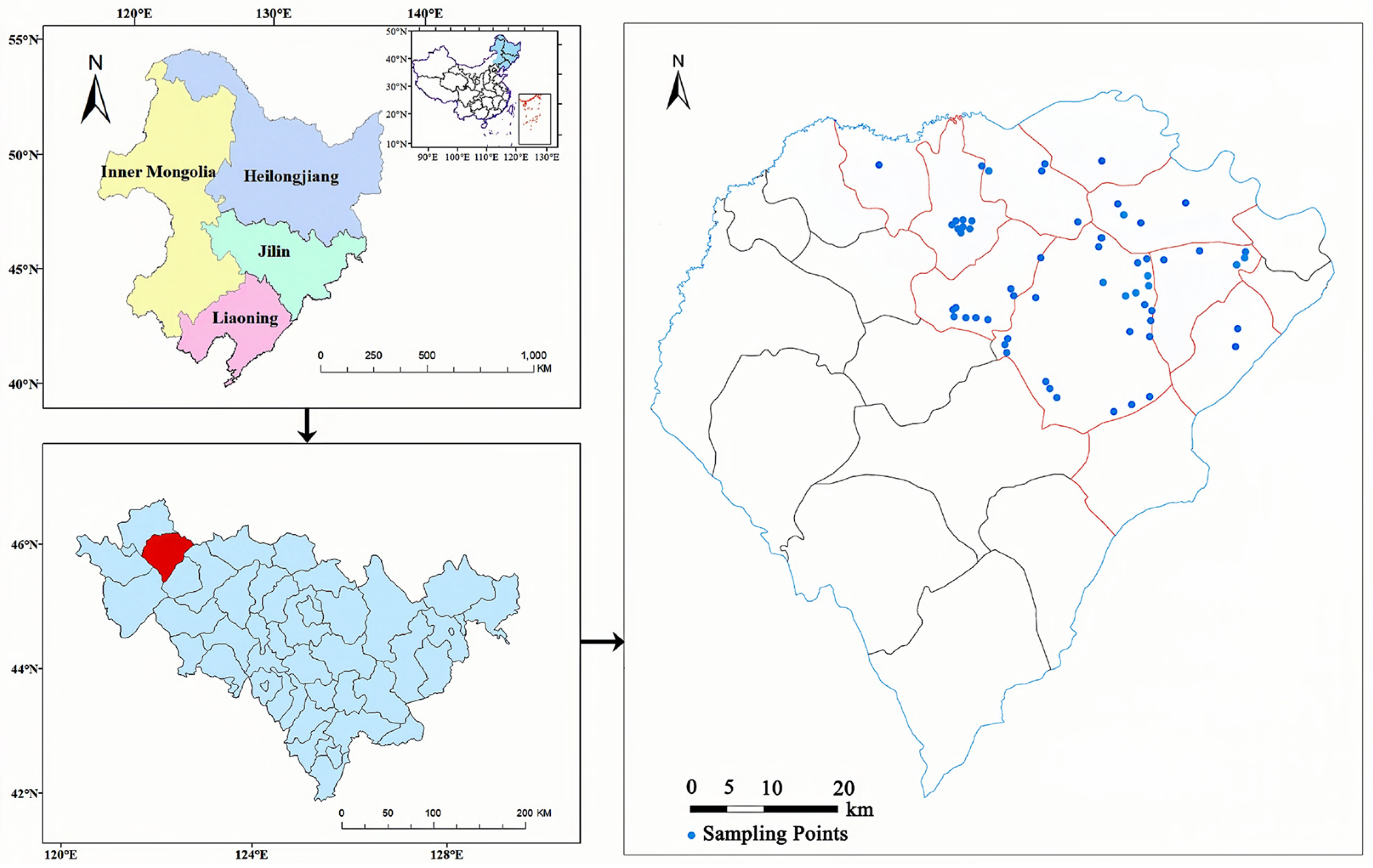



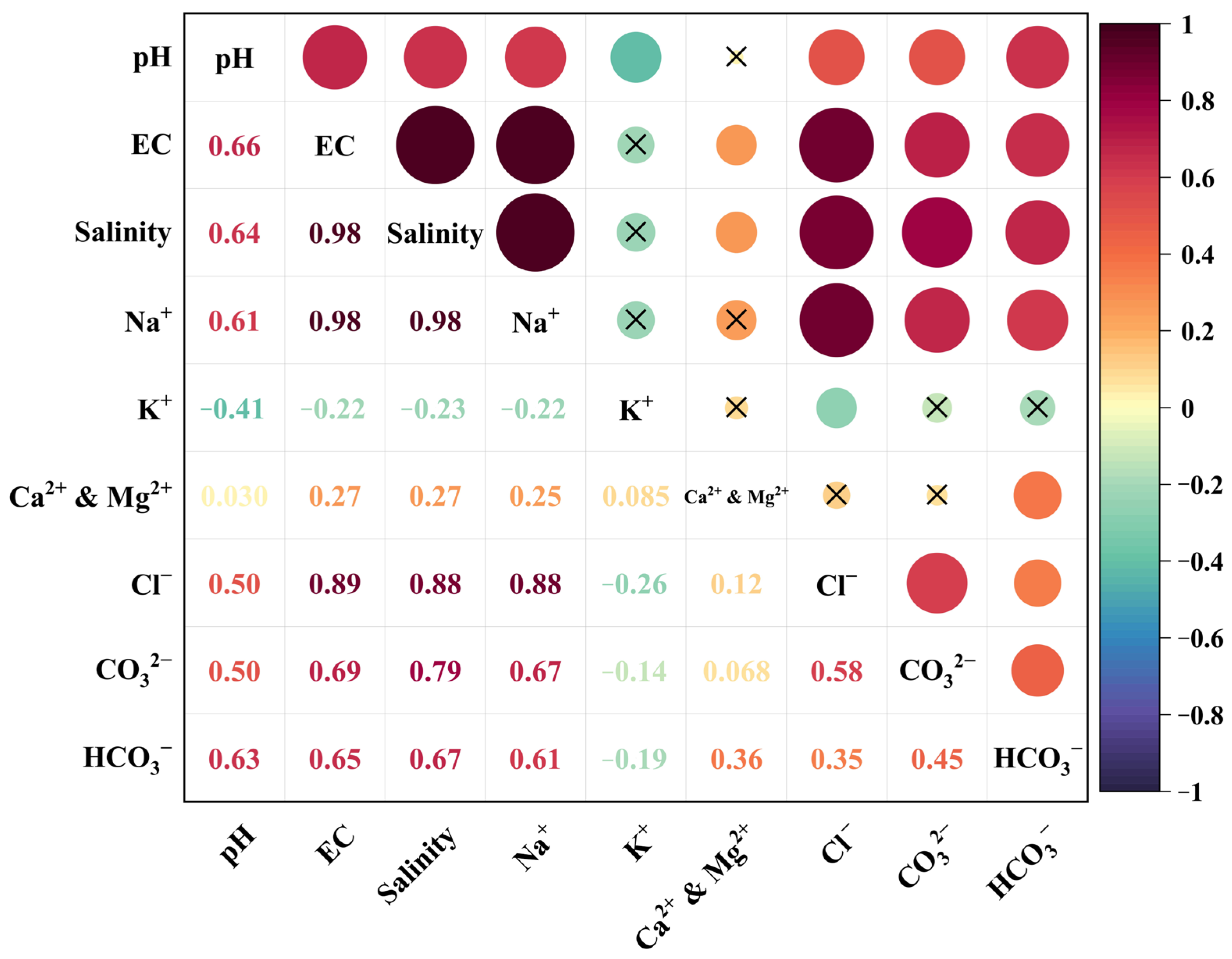

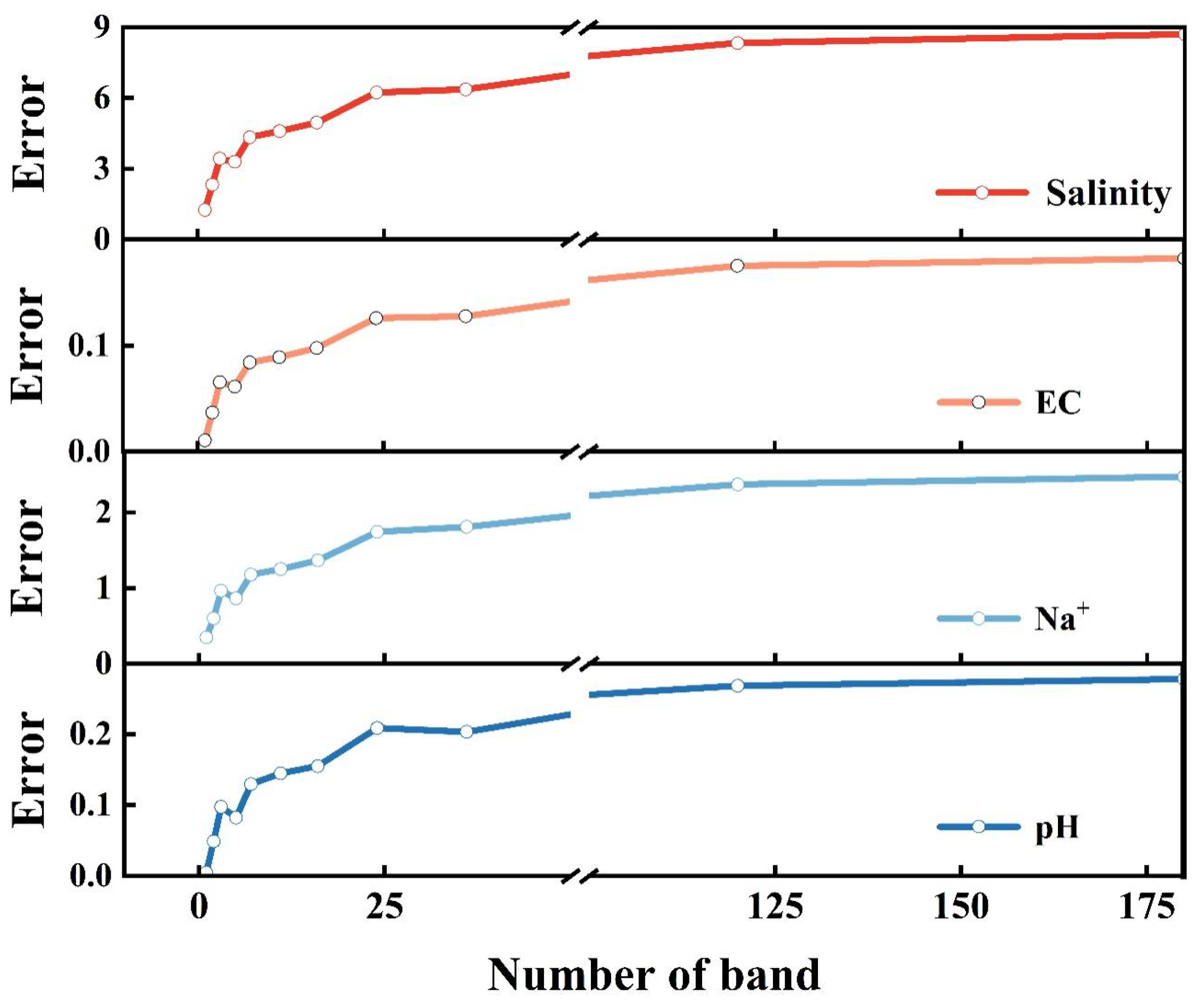
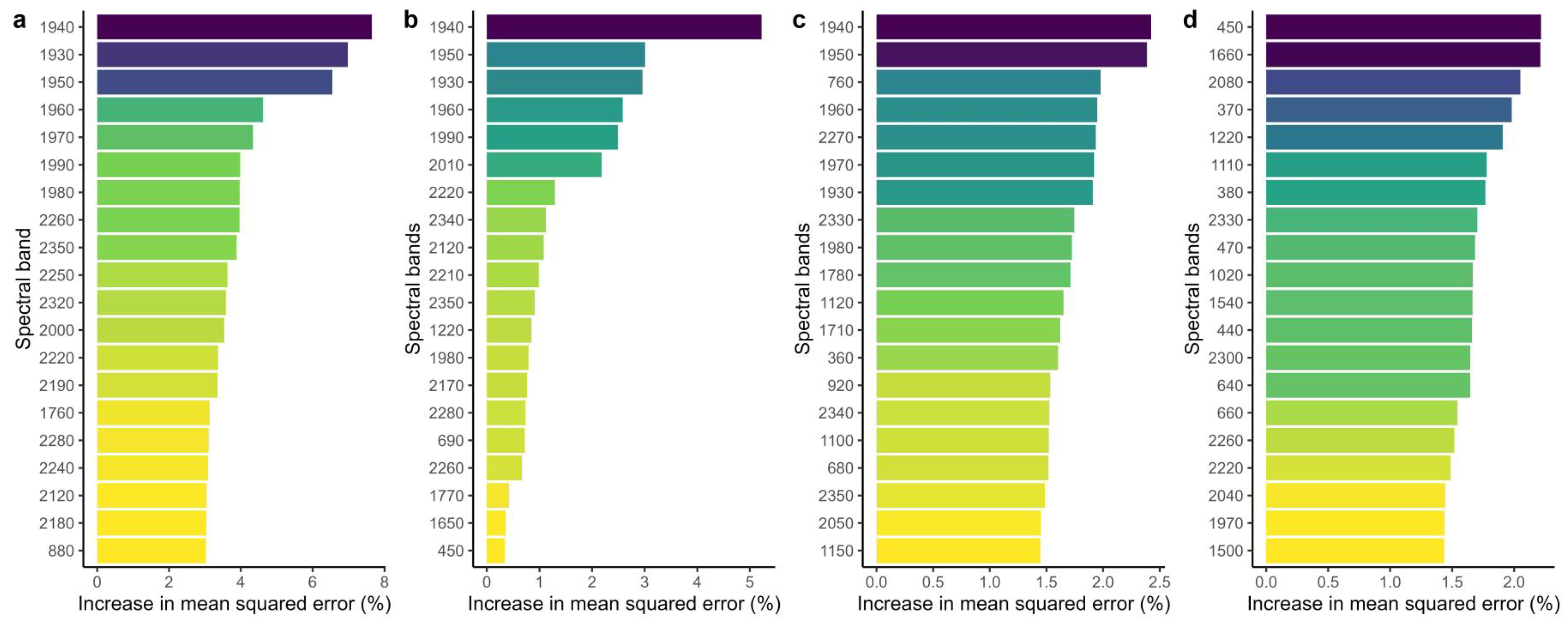


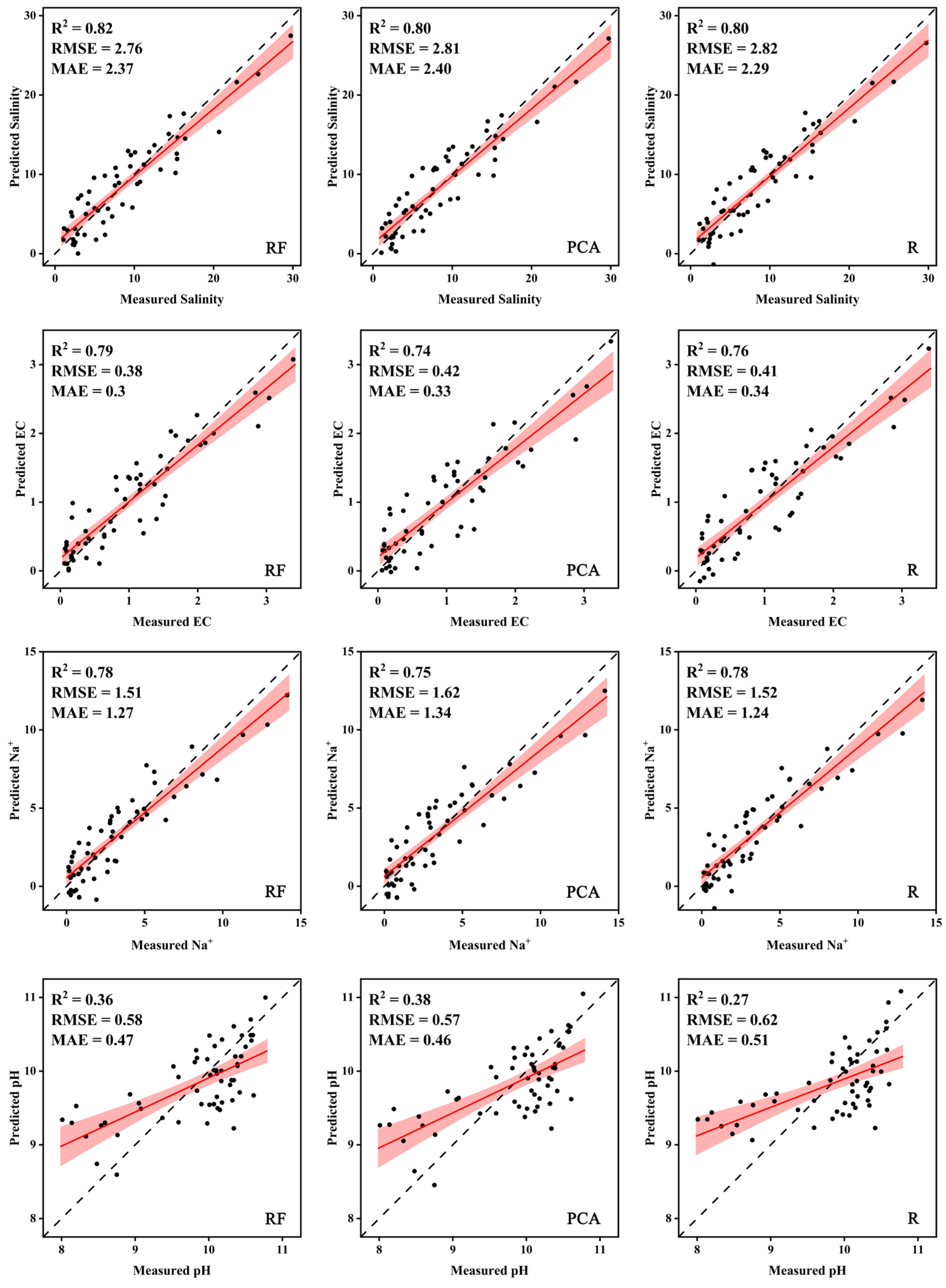
| Soil Parameters | Min | Max | Mean | SD | CV (%) | Skewness | Kurtosis |
|---|---|---|---|---|---|---|---|
| pH | 8.01 | 10.77 | 9.83 | 0.73 | 7.41 | −1.14 | 0.18 |
| EC (ds/m) | 0.06 | 3.39 | 0.97 | 0.84 | 86.64 | 1.02 | 0.56 |
| Na+ (mg/g) | 0.12 | 14.12 | 3.32 | 3.28 | 98.95 | 1.51 | 2.13 |
| K+ (mg/g) | 0.01 | 0.06 | 0.02 | 0.01 | 67.41 | 2.14 | 5.49 |
| Ca2+ and Mg2+ (mg/g) | 0.10 | 1.60 | 0.53 | 0.32 | 59.75 | 1.19 | 1.67 |
| HCO3− (mg/g) | 0.12 | 5.00 | 1.57 | 0.99 | 63.4 | 1.11 | 1.38 |
| CO32− (mg/g) | 0 | 5.50 | 1.75 | 1.56 | 89.33 | 1.02 | 0.14 |
| Cl− (mg/g) | 0.08 | 5.25 | 1.32 | 1.46 | 110.44 | 1.34 | 0.86 |
| Salinity (mg/g) | 1.06 | 29.73 | 8.50 | 6.46 | 75.98 | 1.22 | 1.43 |
| ESP (%) | 0.26 | 47.30 | 10.58 | 9.91 | 93.67 | 1.67 | 3.43 |
| Clay (%) | 25.39 | 32.04 | 27.98 | 1.54 | 5.49 | 0.43 | −0.27 |
| Silt (%) | 28.72 | 40.40 | 35.19 | 3.18 | 9.03 | −0.12 | −0.82 |
| Sand (%) | 28.26 | 43.94 | 36.85 | 3.64 | 9.87 | −0.21 | −0.85 |
| Crack Parameters | Min | Max | Mean | SD | CV (%) | Skewness | Kurtosis |
|---|---|---|---|---|---|---|---|
| CL (cm) | 200.00 | 797.18 | 444.26 | 120.65 | 27.16 | 0.54 | 0.58 |
| CA (cm2) | 36.78 | 547.54 | 311.80 | 130.80 | 41.95 | −0.08 | −0.78 |
| pH | EC | Na+ | K+ | Ca2+ & Mg2+ | HCO3− | CO32− | Cl− | Salinity | Clay | Silt | Sand | |
|---|---|---|---|---|---|---|---|---|---|---|---|---|
| CL | 0.66 | 0.92 | 0.91 | −0.25 | 0.25 | 0.62 | 0.76 | 0.83 | 0.94 | 0.14 | 0.23 | −0.26 |
| CA | 0.45 | 0.55 | 0.50 | −0.28 | 0.08 | 0.47 | 0.31 | 0.50 | 0.52 | 0.26 | 0.04 | −0.15 |
| Component | Total | Contribution Rate (%) | Cumulative Contribution Rate (%) |
|---|---|---|---|
| 1 | 159.62 | 88.68 | 88.68 |
| 2 | 15.92 | 8.85 | 97.53 |
| 3 | 3.54 | 1.96 | 99.49 |
| 4 | 0.60 | 0.33 | 99.82 |
| 5 | 0.16 | 0.09 | 99.91 |
| Salt Parameters | Filtering Algorithm | Characteristic Band |
|---|---|---|
| —— | PCA | PC1 (X1), PC2 (X2), PC3 (X3), PC4 (X4), PC5 (X5) |
| —— | R | B1470 (X1), B1990 (X2), B2170 (X3), B990 (X4), B1340 (X5) |
| Salinity | RF | B1940 (X1), B1930 (X2), B1950 (X3), B1960 (X4), B1970 (X5) |
| EC | B1940 (X1), B1950 (X2), B1930 (X3), B1960 (X4), B1990 (X5) | |
| Na+ | B1940 (X1), B1950 (X2), B760 (X3), B1960 (X4), B2270 (X5) | |
| pH | B450 (X1), B1660 (X2), B2080 (X3), B370 (X4), B1220 (X5) |
Disclaimer/Publisher’s Note: The statements, opinions and data contained in all publications are solely those of the individual author(s) and contributor(s) and not of MDPI and/or the editor(s). MDPI and/or the editor(s) disclaim responsibility for any injury to people or property resulting from any ideas, methods, instructions or products referred to in the content. |
© 2024 by the authors. Licensee MDPI, Basel, Switzerland. This article is an open access article distributed under the terms and conditions of the Creative Commons Attribution (CC BY) license (https://creativecommons.org/licenses/by/4.0/).
Share and Cite
Li, K.; Zhou, H.; Ren, J.; Liu, X.; Zhang, Z. A Comparative Study of Different Dimensionality Reduction Algorithms for Hyperspectral Prediction of Salt Information in Saline–Alkali Soils of Songnen Plain, China. Agriculture 2024, 14, 1200. https://doi.org/10.3390/agriculture14071200
Li K, Zhou H, Ren J, Liu X, Zhang Z. A Comparative Study of Different Dimensionality Reduction Algorithms for Hyperspectral Prediction of Salt Information in Saline–Alkali Soils of Songnen Plain, China. Agriculture. 2024; 14(7):1200. https://doi.org/10.3390/agriculture14071200
Chicago/Turabian StyleLi, Kai, Haoyun Zhou, Jianhua Ren, Xiaozhen Liu, and Zhuopeng Zhang. 2024. "A Comparative Study of Different Dimensionality Reduction Algorithms for Hyperspectral Prediction of Salt Information in Saline–Alkali Soils of Songnen Plain, China" Agriculture 14, no. 7: 1200. https://doi.org/10.3390/agriculture14071200
APA StyleLi, K., Zhou, H., Ren, J., Liu, X., & Zhang, Z. (2024). A Comparative Study of Different Dimensionality Reduction Algorithms for Hyperspectral Prediction of Salt Information in Saline–Alkali Soils of Songnen Plain, China. Agriculture, 14(7), 1200. https://doi.org/10.3390/agriculture14071200






